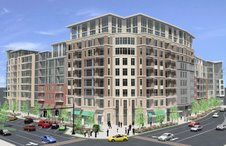The rising costs of commuting are driving Americans back to downtown living.
The Avenue District, located at East 12th Street and St. Clair Avenue in downtown Cleveland, is designed as a walkable neighborhood, placing residents in walking distance to shopping, dining, arts, work and more. Its central proximity to several major Cleveland districts is a strong advantage for those looking to eliminate their dependence on cars, and make the lifestyle change from suburban to urban living.
The Avenue District is not alone in this transformation, as there are multiple revitalization projects underway throughout Cleveland, that will connect segments of downtown and set the stage for a thoroughly walkable metropolis.
The following three-part blog series will take a look at the financial, environmental and health advantages of walkable neighborhoods, and the significance of downtown Cleveland taking this first step in bringing residents back to the City.
PART ONE: TRACKING NATIONAL TRENDS
On any given day, media coverage is dominated by the topic of rising fuel costs. In addition to the impact on peoples’ wallets, and the trickle-down effect throughout the economy, new emphasis is being placed on the ongoing environmental issues of fuel consumption and non-renewable energy sources.
Suburbs a Mile Too Far for Some - Demographic Changes, High Gasoline Prices May Hasten Demand for Urban Living
Jonathan Karp - Wall Street Journal
Tuesday, June 17, 2008
"In recent years, a generation of young people, called the millennials, born between the late 1970s and mid-1990s, has combined with baby boomers to rekindle demand for urban living. Today, the subprime-mortgage crisis and $4-a-gallon gasoline are delivering further gut punches by blighting remote subdivisions nationwide and rendering long commutes untenable for middle-class Americans..."
Is America's suburban dream collapsing into a nightmare?
Lara Farrar - CNN
Monday, June 16, 2008
"Instead, they are looking for what Leinberger calls "walkable urbanism" -- both small communities and big cities characterized by efficient mass transit systems and high density developments enabling residents to walk virtually everywhere for everything -- from home to work to restaurants to movie theaters.
The so-called New Urbanism movement emerged in the mid-90s and has been steadily gaining momentum, especially with rising energy costs, environmental concerns and health problems associated with what Leinberger calls "drivable suburbanism" -- a low-density built environment plan that emerged around the end of the World War II and has been the dominant design in the U.S. ever since..."
Market blamed for fuel costsBob Dart - Cox News Service
Wednesday, June 4, 2008
“Gasoline should cost about $2.25 a gallon at the pump, and everything above that is "funny money" largely tacked on by speculation and manipulation in the energy markets, a consumer advocate told a Senate committee Tuesday…”
As gas prices rise, commuters hop on mass transit wagon
Sarah Karush - Associated Press
Wednesday, June 4, 2008
"Around the country, high gas prices are pushing more people to leave their cars at home and crowd onto trains, buses and subways…”
Small cars overtake Ford trucks
Dee-Ann Durbin - Associated Press
Wednesday, June 4, 2008
“U.S. auto sales in May brought the starkest signs yet that gas prices have dramatically shifted the market to smaller cars, as the top-selling Ford F-series truck was dethroned by cars from Toyota and Honda…”



